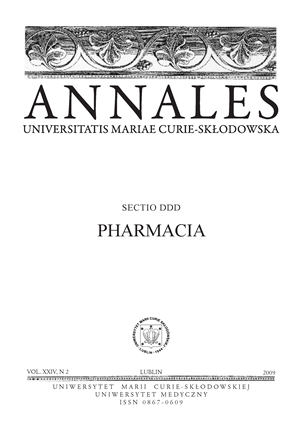Aktywność enzymów lizosomalnych w jądrze królika w cukrzycy doświadczalnej
DOI:
https://doi.org/10.2478/v10080-008-0191-xAbstrakt
Cukrzyca jest schorzeniem metabolicznym, powstającym na podłożu genetycznym w wyniku działania niekorzystnych czynników środowiskowych. Jednym z jej powikłań jest niepłodność męska i zaburzenia hormonalne, w tym nieprawidłowy poziom testosteronu. Celem pracy była ocena aktywności wybranych enzymów lizosomalnych w jądrach królika w przebiegu cukrzycy 140 Z. Wójtowicz, W. Dworzański, A. Kędzierawska-Kurylcio, J. Dworzański, J. G. Kiś... doświadczalnej. Dorosłe samce królika rasy nowozelandzkiej białej były losowo przydzielane do grupy kontrolnej i grup doświadczalnych, w których cukrzycę wywoływano poprzez dożylne podanie alloksanu. Zwierzęta usypiano w 21, 42, 90 i 180 dniu, a podczas sekcji pobierano jądra. W homogenatach jąder oznaczono spektrofotometrycznie aktywność frakcji wolnej i związanej fosfatazy kwaśnej, beta-galaktozydazy, beta-N-acetylo-glukozaminidazy (NAGL), katepsyny B, D i L, lipazy oraz sulfatazy. Aktywność frakcji związanej NAGL, katepsyn i lipazy była istotnie zwiększona w 21 dniu od rozpoznania cukrzycy. Znamienne obniżenie aktywności frakcji związanej NAGL, katepsyny B i sulfatazy oraz zwiększenie aktywności katepsyny D wykazano w 42 dniu. Jednocześnie zanotowano istotny wzrost aktywności frakcji wolnej fosfatazy kwaśnej i katepsyny D. W 90 dniu obserwowano ponadto wzrost aktywności obu frakcji katepsyny L. Aktywność badanych enzymów nie wykazywała istotnych różnic w ostatnim dniu doświadczenia. Otrzymane wyniki wskazują na związek zaburzeń aktywności większości badanych enzymów lizosomalnych w jądrach z niepłodnością męską.
Bibliografia
1. Barrett A. J.: Lysosomal enzymes. In: Dingle J. T. (ed) Lysosomes. North-Holland Publishing Co, Amsterdam 1972.
2. Beattie G. M. et al.: Acid beta-galactosidase: a developmentally regulated marker of endocrine cell precursors in the human fetal pancreas. J. Clin. Endocrinol. Metab., 78, 1232, 1994.
3. Bener A. et al.: Is male fertility associated with type 2 diabetes mellitus?. Int. Urol. Nephrol. 2009 – in press.
4. Burdan F. et al.: The activity and immunoexpression of cathepsin D in rat male reproductive organs. Folia Morphol., 65, 111, 2006.
5. Burdan F. et al.: Hepatic lysosomal enzymes activity and liver morphology after short-time omeprazole administration. Exp. Toxicol. Pathol., 53, 453, 2002.
6. Burlina A. B. et al.: Behaviour of some lysosomal enzymes in the plasma of insulin dependent diabetic patients during artificial pancreas treatment. Clin. Biochem., 20, 423, 1987.
7. Corona G. et al.: Why can patients with erectile dysfunction be considered lucky? The association with testosterone deficiency and metabolic syndrome. Aging Male, 11, 193, 2008.
8. Garcia-Pascual J. J. et al.: Enzymatic glycosidase activities in experimental obesity. Horm. Metab. Res., 24, 412, 1992.
9. Górska P.: Principles in laboratory animal research for experimental purposes. Med. Sci. Monit., 6, 171, 2000.
10. Kim S. T., Moley K. H.: Paternal effect on embryo quality in diabetic mice is related to poor sperm quality and associated with decreased glucose transporter expression. Reproduction, 136, 313, 2008.
11. La Vignera S. et al.: Andrological characterization of the patient with diabetes mellitus. Minerva Endocrinol., 34, 1, 2009.
12. Maciejewski R. et. al.: Changes of the ATPase, acid phosphatase and alkaline phosphatase reaction intensity in the parotid and submandibular glands of rabbits in experimental diabetes. Folia Histochem. Cytobiol., 37, 99, 1999.
13. Maciejewski R. et al.: Changes in the activities of pancreatic cathepsins D and L and acid phosphatase in the course of alloxan-induced diabetes mellitus in rabbit. Med. Sci. Res., 28, 113, 2000.
14. Maciejewski R. et. al.: Changes in pancreatic lysosomal enzymes activity as the potential factors leading to diabetic enteropathy. J. Physiol. Pharmacol., 52, 823, 2001.
15. Saad F., Gooren L.: The role of testosterone in the metabolic syndrome: a review. J. Steroid Biochem. Mol. Biol., 114, 40, 2009.
16. Shirneshan K. et al.: Directed overexpression of insulin in Leydig cells causes a progressive loss of germ cells. Mol. Cell Endocrinol., 295, 79, 2008.
17. Strawser L. D., Touster O.: The cellular processing of lysosomal enzymes and related proteins. Rev. Physiol. Biochem. Pharmacol., 87, 169, 1980.
18. Taczała S. et. al.: The activity of some lysosomal enzymes of the thymus in rabbits. Annales UMCS, Sect. D, 49, 87, 1994.
19. Tong P. C. et al.: Association of testosterone, insulin-like growth factor-I, and C-reactive protein with metabolic syndrome in Chinese middle-aged men with a family history of type 2 diabetes Med. Sci. Monit., 6, 171, 2000.
20. Wójtowicz Z. et. al.: The activity of lysosomal enzymes in visual cortex of rabbits during experimental diabetes. Folia Neuropathol., 33, 159, 1995.
21. Wójtowicz Z. et. al.: The activity of lysosomal enzymes of the basilar artery wall on rabbits of different breed. Annales UMCS, Sect. D, 49, 141, 1994.
22. Wójtowicz Z. et. al.: Lysosomal enzyme activity of internal and middle layers of renal arterial wall in rabbits. Annales UMCS, Sect. D, 53, 153, 1998.
23. Wójtowicz Z. et. al.: The activity of lysosomal enzymes of rabbits gingiva mucosa during induced experimental diabetes. Annales UMCS, Sect. D, 60, 369, 2005.
24. Wójtowicz Z. et al.: Hepatic lysosomal enzymes activity turning the course of the experimental diabetes in rabbit. Annales UMCS, Sect. D, 60, 908, 2005.
25. Wójtowicz Z. et al.: The activity of lysosomal enzymes of rabbit thyroid gland during induced experimental diabetes. Annales UMCS, Sect. D, 61, 748, 2006.
26. Wójtowicz Z. et al.: The activity of lysosomal enzymes of rabbit skeletal muscles during induced experimental diabetes. Annales UMCS, Sect. D, 60, 369, 2005.
Pobrania
Opublikowane
Numer
Dział
Licencja
Prawa autorskie (c) 2009 Autorzy

Praca jest udostępniana na licencji Creative Commons Attribution-NonCommercial-NoDerivatives 3.0 Unported License.


